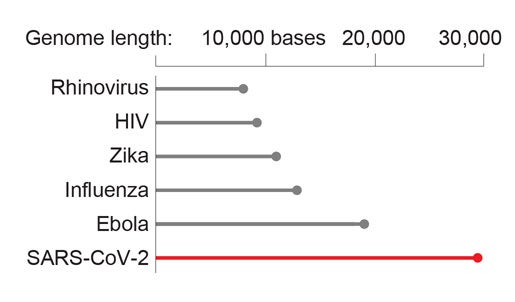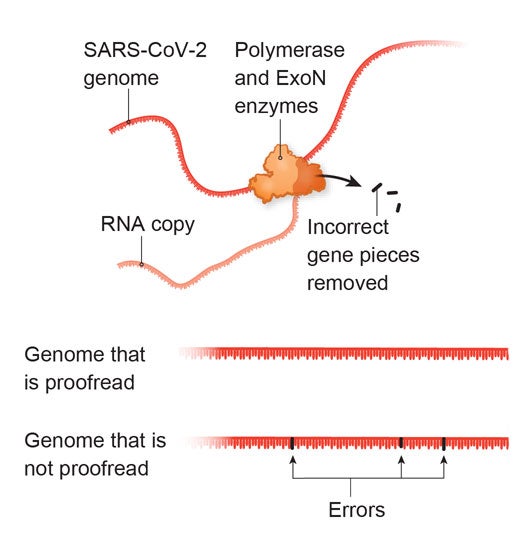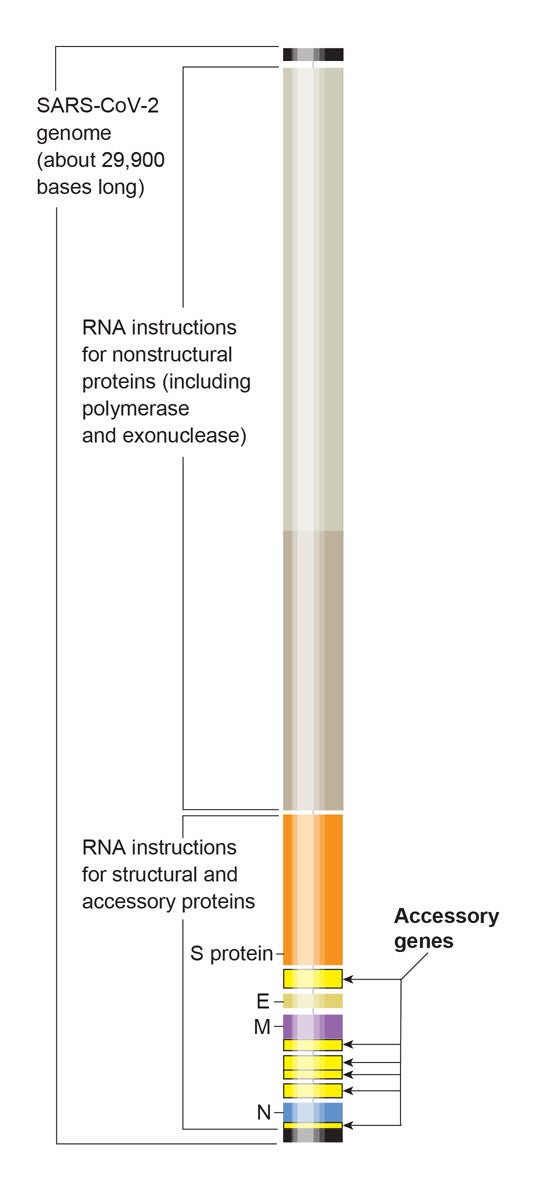CORONAVIRUS
Inside the Coronavirus
What scientists know about the inner workings of the pathogen that has infected the worldBy
Mark Fischetti | Graphics by
Veronica Falconieri Hays | Consultant:
Britt GlaunsingerFor all the mysteries that remain about the novel coronavirus and the COVID-19 disease it causes, scientists have generated an incredible amount of fine-grained knowledge in a surprisingly short time.
In the graphics that follow, Scientific American presents detailed explanations, current as of mid-June, into how SARS-CoV-2 sneaks inside human cells, makes copies of itself and bursts out to infiltrate many more cells, widening infection. We show how the immune system would normally attempt to neutralize virus particles and how CoV-2 can block that effort. We explain some of the virus's surprising abilities, such as its capacity to proofread new virus copies as they are being made to prevent mutations that could destroy them. And we show how drugs and vaccines might still be able to overcome the intruders.
A SARS-CoV-2 virus particle wafting into a person's nose or mouth is about 100 nanometers in diameter--visible only with an electron microscope. It is a near sphere of protein (cross section shown) inside a fatty membrane that protects a twisting strand of RNA--a molecule that holds the virus's genetic code. Proteins called "S" form spikes that extend from the surface and grab onto a human cell, hundreds of times larger, so the particle, or virion, can slip inside; the crown, or corona, appearance gives the virus its name. Structural proteins--N, M and E--move inside the cell, where they help new virions form.
.jpg)
1. The virus: The SARS-CoV-2 virus particle is a ball of proteins wrapped in a protective fatty coating.
2. RNA (red): This twisting strand of RNA is the blueprint the virus uses to replicate itself inside of you.
3. Entry spikes (Orange): The virus uses its spike-shaped S proteins, which stud the surface, to grab onto human cells.
4. Protective shell: This lipid bilayer protects the virus's genetic cargo as it travels inside the body.
5. N Protein (Blue): This protein helps keep the viral RNA stable.
6. E Protein (Yellow): This protein helps new virus particles form.
7. M Protein (Purple): This protein helps new virus particles form.
HOW THE VIRUS INVADES
A SARS-CoV-2 particle enters a person's nose or mouth and floats in the airway until it brushes against a lung cell that has an ACE2 receptor on the surface. The virus binds to that cell, slips inside and uses the cell's machinery to help make copies of itself. They break out, leaving the cell for dead, and penetrate other cells.
Swipe to advance through slides
First, It Binds to a Lung CellWhen a virus spike protein latches onto an ACE2 receptor, a protease enzyme slices off the spike's head. (ACE2 normally helps regulate blood pressure.)
HOW THE IMMUNE SYSTEM RESPONDS
Infected cells send out alarms to the immune system to try to neutralize or destroy the pathogens, but the viruses can prevent or intercept the signals, buying time to replicate widely before a person shows symptoms. When infection begins, the innate immune system tries to immediately protect lung cells. The adaptive immune system gears up for a greater response.
Swipe to advance through slides
The Innate Immune System Acts First: An infected cell releases interferon proteins that alert neighboring cells to create molecules that try to stop virus particles (red dots) from entering or reproducing. Interferon also beckons cells such as macrophages in the bloodstream that can engulf virus particles.TIME ELAPSED: 0–3 DAYS
DRUG AND VACCINE INTERVENTIONS
Commercial and university labs are investigating well over 100 drugs to fight COVID-19, the disease the SARS-CoV-2 virus causes. Most drugs would not destroy the virus directly but would interfere with it enough to allow the body's immune system to clear the infection. Antiviral drugs generally stop a virus from attaching to a lung cell, prevent a virus from reproducing if it does invade a cell, or dampen an overreaction by the immune system, which can cause severe symptoms in infected people. Vaccines prepare the immune system to quickly and effectively fight a future infection.
Swipe to advance through slides
Drug Target 1Prevent the Virus from Entering the Cell: A drug or therapeutic antibodies could lock on to the spike protein, preventing it from binding to a lung cell’s ACE2 receptor. A drug could also attach to the protease enzyme and prevent it from cutting the spike protein so the virus cannot fuse with the cell.
THE REMARKABLE AND MYSTERIOUS CORONAVIRUS GENOME
The SARS-CoV-2 genome is a strand of RNA that is about 29,900 bases long--near the limit for RNA viruses. Influenza has about 13,500 bases, and the rhinoviruses that cause common colds have about 8,000. (A base is a pair of compounds that are the building blocks of RNA and DNA.) Because the genome is so large, many mutations could occur during replication that would cripple the virus, but SARS-CoV-2 can proofread and correct copies. This quality control is common in human cells and in DNA viruses but highly unusual in RNA viruses. The long genome also has accessory genes, not fully understood, some of which may help it fend off our immune system.

ProofreadingBecause the SARS-CoV-2 genome is so long, it can encode a huge amount of information, enabling the novel coronavirus to create more proteins and perhaps carry out more sophisticated replication strategies than other RNA viruses. One of these advantageous proteins is an enzyme called exonuclease (ExoN), which helps the virus proofread and correct copies as they are made. Only viruses with genomes longer than about 20,000 bases make this enzyme.

Once a SARS-CoV-2 virus has infected a lung cell, an enzyme called polymerase starts to make copies of its RNA while another enzyme, ExoN, finds random mutations and expels these genetic mistakes from the copies.

Accessory GenesUnusual, short bits of the genome called accessory genes are clustered with the structural protein genes. Researchers are not yet sure what they do. Several are thought to encode proteins that help the virus evade the immune system.

.jpg)
 ProofreadingBecause the SARS-CoV-2 genome is so long, it can encode a huge amount of information, enabling the novel coronavirus to create more proteins and perhaps carry out more sophisticated replication strategies than other RNA viruses. One of these advantageous proteins is an enzyme called exonuclease (ExoN), which helps the virus proofread and correct copies as they are made. Only viruses with genomes longer than about 20,000 bases make this enzyme.
ProofreadingBecause the SARS-CoV-2 genome is so long, it can encode a huge amount of information, enabling the novel coronavirus to create more proteins and perhaps carry out more sophisticated replication strategies than other RNA viruses. One of these advantageous proteins is an enzyme called exonuclease (ExoN), which helps the virus proofread and correct copies as they are made. Only viruses with genomes longer than about 20,000 bases make this enzyme. Once a SARS-CoV-2 virus has infected a lung cell, an enzyme called polymerase starts to make copies of its RNA while another enzyme, ExoN, finds random mutations and expels these genetic mistakes from the copies.
Once a SARS-CoV-2 virus has infected a lung cell, an enzyme called polymerase starts to make copies of its RNA while another enzyme, ExoN, finds random mutations and expels these genetic mistakes from the copies. Accessory GenesUnusual, short bits of the genome called accessory genes are clustered with the structural protein genes. Researchers are not yet sure what they do. Several are thought to encode proteins that help the virus evade the immune system.
Accessory GenesUnusual, short bits of the genome called accessory genes are clustered with the structural protein genes. Researchers are not yet sure what they do. Several are thought to encode proteins that help the virus evade the immune system.

Comments
Post a Comment